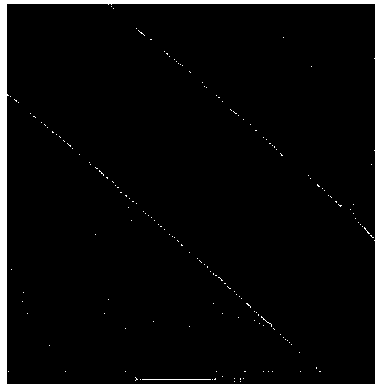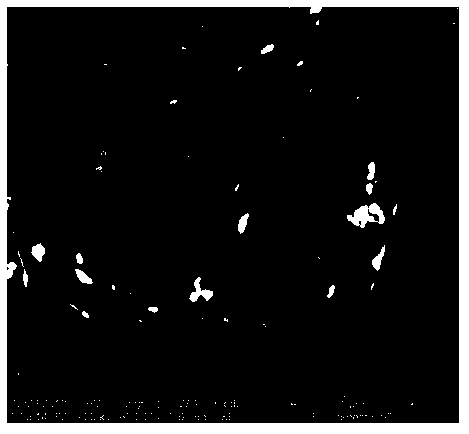Aluminum oxide/titanium oxide heterojunction nano fiber carrier in anti-sintering precious metal catalyst system as well as preparation method and application of carrier
A precious metal catalyst, nanofiber technology, applied in catalyst supports, metal/metal oxide/metal hydroxide catalysts, chemical instruments and methods, etc., can solve the problem of catalyst sintering, agglomeration intensification, surface active site decrease, specific surface area Reduce and other problems, to achieve the effect of short cycle, simple process and high porosity
- Summary
- Abstract
- Description
- Claims
- Application Information
AI Technical Summary
Problems solved by technology
Method used
Image
Examples
Embodiment 1
[0034] a. Disperse PVP in 10mL of solvent with a concentration of 0.24g / mL; add 3mL of glacial acetic acid; then add isopropyl titanate to prepare a solution with a concentration of 1.1mol / L;
[0035] b. Dissolving aluminum acetylacetonate in acetone solvent to prepare a solution with a concentration of 0.37mol / L;
[0036]c. Mix and stir the above two solutions according to the Al:Ti molar ratio of 1:5, then draw the prepared precursor solution into the syringe 2mL, insert the syringe into the micro-injection pump, connect the electrodes, adjust the flow rate to 0.3mL / h, and the electrostatic field voltage The voltage is 15kV, the distance between the needle and the receiver is 10cm, and the humidity in the control room is 30%, then nanofibers can be obtained;
[0037] d. The nanofibers obtained by electrospinning were sintered in a muffle furnace at 450°C for 270min, and the heating rate was 2.8°C / min; a new type of Al 2 o 3 / TiO 2 Heterojunction nanofibrous support; Al 2...
Embodiment 2
[0041] a. Disperse PVP in 10mL of solvent with a concentration of 0.24g / mL; add 3mL of glacial acetic acid; then add isopropyl titanate to prepare a solution with a concentration of 1.1mol / L;
[0042] b. Dissolving aluminum acetylacetonate in acetone solvent to prepare a solution with a concentration of 0.31mol / L;
[0043] c. Mix and stir the above two solutions according to the Al:Ti molar ratio of 1:10, then suck the prepared precursor solution into the syringe 2mL, insert the syringe into the micro-injection pump, connect the electrode, adjust the flow rate to 0.3mL / h, and the electrostatic field voltage The voltage is 15kV, the distance between the needle and the receiver is 10cm, and the humidity in the control room is 30%, then nanofibers can be obtained;
[0044] d. The nanofibers obtained by electrospinning were sintered in a muffle furnace at 1000°C for 60 minutes, and the heating rate was 2.8°C / min; a new type of Al 2 o 3 / TiO 2 Heterojunction nanofibrous support;...
Embodiment 3
[0048] a. Disperse PVP in 10mL of ethanol with a concentration of 0.24g / mL; add 3mL of glacial acetic acid; then add isopropyl titanate to prepare a solution with a concentration of 1.1mol / L;
[0049] b. Dissolving aluminum acetylacetonate in acetone solvent to prepare a solution with a concentration of 0.37mol / L;
[0050] c. Mix and stir the above two solutions according to Al:Ti molar ratio of 1:5, then draw the prepared precursor solution into the syringe 2mL, insert the syringe into the micro-injection pump, connect the electrode, adjust the flow rate to 0.3mL / h, and the electrostatic field The voltage is 15kV, the distance between the needle and the receiver is 10cm, and the humidity in the control room is 30%, then nanofibers can be obtained;
[0051] d. The nanofibers obtained by electrospinning were sintered in a muffle furnace at 350°C for 270min, and the heating rate was 2.8°C / min; a new type of Al 2 o 3 / TiO 2 Heterojunction nanofiber carrier;
[0052] e. Al 2 ...
PUM
 Login to View More
Login to View More Abstract
Description
Claims
Application Information
 Login to View More
Login to View More - R&D
- Intellectual Property
- Life Sciences
- Materials
- Tech Scout
- Unparalleled Data Quality
- Higher Quality Content
- 60% Fewer Hallucinations
Browse by: Latest US Patents, China's latest patents, Technical Efficacy Thesaurus, Application Domain, Technology Topic, Popular Technical Reports.
© 2025 PatSnap. All rights reserved.Legal|Privacy policy|Modern Slavery Act Transparency Statement|Sitemap|About US| Contact US: help@patsnap.com



